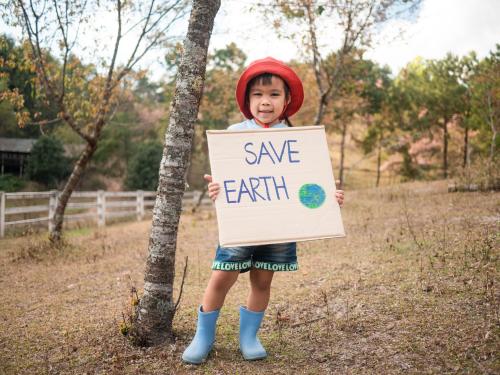This analysis marks the second blog in a series based on the report “A new green learning agenda: Approaches to quality education for climate action.” It was updated on March 3, 2021 to reflect that the secretary of education is now part of the newly established Climate Policy Office and the National Climate Task Force.
On January 27, President Biden signed an historic executive order that put tackling the climate crisis at the top of both domestic and foreign policy. Key among its goals is to “create well-paying union jobs to build a modern and sustainable infrastructure, deliver an equitable, clean energy future, and put the United States on a path to achieve net-zero emissions, economy-wide, by no later than 2050.”
Yet, there is a blind spot in this vision. Without a plan to address educational inequalities for girls, focusing solely on green jobs will not achieve an equitable path to a net-zero future. For starters, in 2018, women in the U.S. earned just 36 percent of bachelor’s degrees in STEM fields of study, while women of color merely earned 14 percent. STEM fields are where many green jobs in sustainable infrastructure, renewable energy, low-carbon manufacturing, and green construction are expected to emerge. Yet girls and women will miss their opportunity to participate because they will have missed the opportunity to build requisite skills, capital, and networks.
Without a plan to address educational inequalities for girls, focusing solely on green jobs will not achieve an equitable path to a net-zero future.
Such circumstances extend to girls beyond our borders, too, and are exacerbated in low- and middle-income countries where—during pre-COVID times—over 130 million girls were out of school due to time poverty, a lack of access to proper menstrual hygiene, early childbearing, gender-based violence, and/or child marriage. Education as we know it cannot support a just transition without the implementation of a new green learning agenda that intentionally tackles gender inequality while building girls’ and boys’ green skills.
The good news is that addressing gender inequitable pathways to green jobs, both at home and abroad, is perhaps the most politically feasible approach to doing education differently for people and planet. As discussed in my recent Brookings report, which introduces three approaches to education systems transformation for climate action and climate justice, framing the climate crisis in terms of carbon emissions and framing the solution in terms of a green economy points decisionmakers to the first of the three green learning agendas: gender-transformative technical and vocational education and training (TVET). (Subsequent blogs in this series will discuss when the second and third approaches may be relevant.)
To center gender empowerment in green TVET efforts, four actions must be taken:
- Transform underlying systems, structures, and norms in TVET that have left girls out. TVET has emerged as a critical pathway for upskilling and reskilling the labor force to meet the demands of a green economy. But there must simultaneously be renewed efforts at ensuring TVET is gender inclusive, gender empowering, and gender transformative. Not only do we need to eliminate gender stereotypes to eliminate barriers to entry, but also to help girls overcome their unique disadvantages to achieve equal outcomes. This means tackling the gender norms, policies, and practices that have segregated girls out of STEM and other related technical fields of training and work.
- Redefine green jobs to prioritize care. Part of transforming efforts to green TVET is to openly challenge how the nature of green jobs and their required skills and capacities are conceived, and how the status quo definitions and frameworks fail to disrupt underlying economic paradigms that ignore and/or undervalue labor often performed by women. To push for fuller integration of gender analysis in the process of forecasting, designing, and delivering green TVET, we must first expand our definition of green jobs to include those that center, nurture, and develop our individual and collective capacity to care for others and the environment and to educate ourselves and others about the unsustainability of the status quo. Such work, including those of health care professionals and educators, is essential for a climate-empowered workforce and a climate resilient society.
- Expand and target green skills from caring to coding to construction. TVET institutions must move beyond a narrow concern for building job-specific technical skills to building a broader set of specific capacities that include sustainability competencies and empowerment skills. Such an approach helps to avoid conflating green skills with STEM skills. Instead, it helps to ensure girls and boys also develop the ability to read, decode, negotiate, and act upon their social environment in empowering ways; the ability to build partnerships and coalitions, solidarity, and reciprocity; and the ability to self-advocate and to advocate for others. In this context, self-awareness and emotional intelligence help to build autonomy and agency that are critical to achieving gender equality, while traditional technical skills help to reduce carbon emissions.
- Create a supportive ecosystem for girls and women in the green economy. Efforts to create pathways for girls to green jobs have typically targeted adolescent girls when negative gender stereotypes about science and math appear to have the greatest impact on girls’ interest in STEM. But research suggests that these stereotypes begin to impact girls even earlier, and that efforts to set girls on a path to STEM-related green jobs may need to start as early as primary school. Mentorship and networking opportunities for girls and women are also critical to supporting girls and young women to transition into green jobs, to develop careers in green sectors, and to assume leadership positions in green industries. As such, a whole of life approach is needed to ensure green TVET initiatives successfully support a just transition.
To set the U.S. on an equitable and just path to a green economy, the Biden administration’s newly established Climate Policy Office and the National Climate Task Force—which now includes the secretary of education—must work together with the newly created Gender Policy Council to take an intersectional feminist approach to the development of green skills for green jobs among the present and future workforce. Such an approach would ensure that girls and women have an equal role as boys and men in shaping a green economy, helping the nation take important steps toward net-zero while also making progress towards climate justice.
For agencies like the U.S. Agency for International Development and the State Department that are critical to U.S. efforts to prioritize climate in foreign policy, investing in girls’ green skills for green jobs is key to our ability to make good on our commitment to support low- and middle-income countries to achieve their climate targets and to empower girls and women. And this is just what the first approach to implementing a new green learning agenda can help to achieve. The next blog in this series will unpack a second approach to education for climate action, illustrating how decisionmakers like those in the Education Department might come to champion green skills across our K-12 education system.







Commentary
The road to a net-zero economy requires building girls’ green skills for green jobs
March 1, 2021